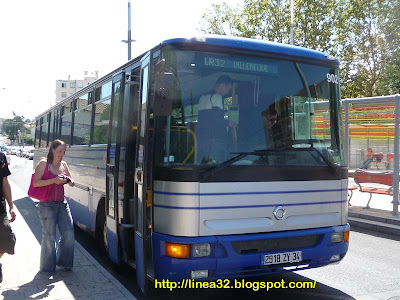 Bilbao tiene poco más de 350.000 habitantes y supera los 900.000 si contamos su entorno metropolitano. La ciudad se encuentra rodeada por montañas que, junto a la ría del Nervión, constituye una importante limitación al desarrollo de la ciudad.
Bilbao tiene poco más de 350.000 habitantes y supera los 900.000 si contamos su entorno metropolitano. La ciudad se encuentra rodeada por montañas que, junto a la ría del Nervión, constituye una importante limitación al desarrollo de la ciudad.Bilbao dispone de una red de autobuses urbanos gestionado por su ayuntamiento se comercializa bajo la marca Bilbobus, en concesión a la empresa francesa Veolia. Dispone de 28 líneas de autobús, 8 de microbús y 8 líneas de autobuses nocturnos durante los fines de semana denominados Gautxoris. Además, dispone de una línea de tranvía operada por Euskotran y dos líneas de metro.
No obstante, Bilbobus no tiene 32, así que he tenido que fijarme en Bizcaiabus, que opera en toda la provincia, con servicios numerados con cuatro cifras. Las dos primeras corresponden a la zona donde operan mayoritariamente: Encartaciones es el 33 (como el 3336, 3337), Margen izquierda el 31 (como el 3115, 3142), UPV el 23 (como el 2312, 2322), Margen derecha el 32 (como el 3250, 3223), Alto Nervión el 36(como el 3621, 3631),... mientras que la segunda cifra es la línea en si.
Así que he cogido la 3632 que comunica Bilbao (c/ Bailén) con Basauri - San Miguel (por Begoña), con una frecuencia de 30 minutos. Además, curiosamente, está operado por TCSA, la concesionaria del autobús urbano de Bilbao antes que se hiciera Veolia con el servicio en 2008. Transportes Colectivos cuenta con una flota de unos 130 autobuses, gestiona 36 de las líneas de Bizkaibus, principalmente realizando las conexiones entre Bilbao, la Margen Izquierda, el Alto Nervión, la Margen Derecha, el Aeropuerto de Bilbao y la UPV.
 Bilbao has little more than 350,000 inhabitants and over 900,000 if we counted its metropolitan surroundings. The city is surrounded by mountains; it’s crossed by the Nervion River that creates a real limitation to the expansion of the city.
Bilbao has little more than 350,000 inhabitants and over 900,000 if we counted its metropolitan surroundings. The city is surrounded by mountains; it’s crossed by the Nervion River that creates a real limitation to the expansion of the city.
It has a network of urban buses managed by its city council, under the Bilbobus mark, in concession to the French company Veolia. It has 28 lines of bus, 8 of minibuses and 8 night services at the weekends called “Gautxoris”. In addition, it has a line of tramway operated by Euskotran and two lines of underground.
However, Bilbobus not has 32, so I have had to look in the Bizcaiabus network that operates throughout the province, with services numbered with four numbers. The first two correspond to the zone where they operate mainly: Encartaciones is the 33 (like the 3336, 3337), Left Bank the 31 (like the 3115, 3142), UPV the 23 (like the 2312, 2322), Right Bank the 32 (like the 3250, 3223), Nervión the 36 (like the 3621, 3631)… whereas the second number is the line itself.
So I have taken the 3632 that communicates Bilbao (Bailén St) with Basauri - San Miguel (via Begoña), with a frequency of 30 minutes. In addition, curiously, it is operated by TCSA, the concessionaire of the urban bus of Bilbao before Veolia wan the service in 2008. Transportes Colectivos has a fleet of about 130 buses, manages 36 of the lines of Bizkaibus, mainly connecting Bilbao, the Left Margin, the Nervión Stop, the Right Margin, the Airport of Bilbao and the UPV.









